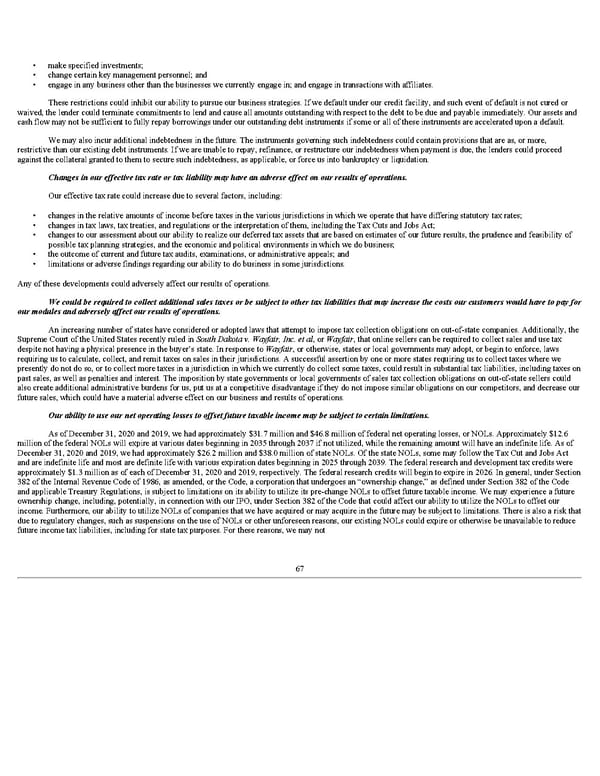• make specified investments; • change certain key management personnel; and • engage in any business other than the businesses we currently engage in; and engage in transactions with affiliates. These restrictions could inhibit our ability to pursue our business strategies. If we default under our credit facility, and such event of default is not cured or waived, the lender could terminate commitments to lend and cause all amounts outstanding with respect to the debt to be due and payable immediately. Our assets and cash flow may not be sufficient to fully repay borrowings under our outstanding debt instruments if some or all of these instruments are accelerated upon a default. We may also incur additional indebtedness in the future. The instruments governing such indebtedness could contain provisions that are as, or more, restrictive than our existing debt instruments. If we are unable to repay, refinance, or restructure our indebtedness when payment is due, the lenders could proceed against the collateral granted to them to secure such indebtedness, as applicable, or force us into bankruptcy or liquidation. Changes in our effective tax rate or tax liability may have an adverse effect on our results of operations. Our effective tax rate could increase due to several factors, including: • changes in the relative amounts of income before taxes in the various jurisdictions in which we operate that have differing statutory tax rates; • changes in tax laws, tax treaties, and regulations or the interpretation of them, including the Tax Cuts and Jobs Act; • changes to our assessment about our ability to realize our deferred tax assets that are based on estimates of our future results, the prudence and feasibility of possible tax planning strategies, and the economic and political environments in which we do business; • the outcome of current and future tax audits, examinations, or administrative appeals; and • limitations or adverse findings regarding our ability to do business in some jurisdictions. Any of these developments could adversely affect our results of operations. We could be required to collect additional sales taxes or be subject to other tax liabilities that may increase the costs our customers would have to pay for our modules and adversely affect our results of operations. An increasing number of states have considered or adopted laws that attempt to impose tax collection obligations on out-of-state companies. Additionally, the Supreme Court of the United States recently ruled in South Dakota v. Wayfair, Inc. et al , or Wayfair , that online sellers can be required to collect sales and use tax despite not having a physical presence in the buyer’s state. In response to Wayfair , or otherwise, states or local governments may adopt, or begin to enforce, laws requiring us to calculate, collect, and remit taxes on sales in their jurisdictions. A successful assertion by one or more states requiring us to collect taxes where we presently do not do so, or to collect more taxes in a jurisdiction in which we currently do collect some taxes, could result in substantial tax liabilities, including taxes on past sales, as well as penalties and interest. The imposition by state governments or local governments of sales tax collection obligations on out-of-state sellers could also create additional administrative burdens for us, put us at a competitive disadvantage if they do not impose similar obligations on our competitors, and decrease our future sales, which could have a material adverse effect on our business and results of operations. Our ability to use our net operating losses to offset future taxable income may be subject to certain limitations. As of December 31, 2020 and 2019, we had approximately $31.7 million and $46.8 million of federal net operating losses, or NOLs. Approximately $12.6 million of the federal NOLs will expire at various dates beginning in 2035 through 2037 if not utilized, while the remaining amount will have an indefinite life. As of December 31, 2020 and 2019, we had approximately $26.2 million and $38.0 million of state NOLs. Of the state NOLs, some may follow the Tax Cut and Jobs Act and are indefinite life and most are definite life with various expiration dates beginning in 2025 through 2039. The federal research and development tax credits were approximately $1.3 million as of each of December 31, 2020 and 2019, respectively. The federal research credits will begin to expire in 2026. In general, under Section 382 of the Internal Revenue Code of 1986, as amended, or the Code, a corporation that undergoes an “ownership change,” as defined under Section 382 of the Code and applicable Treasury Regulations, is subject to limitations on its ability to utilize its pre-change NOLs to offset future taxable income. We may experience a future ownership change, including, potentially, in connection with our IPO, under Section 382 of the Code that could affect our ability to utilize the NOLs to offset our income. Furthermore, our ability to utilize NOLs of companies that we have acquired or may acquire in the future may be subject to limitations. There is also a risk that due to regulatory changes, such as suspensions on the use of NOLs or other unforeseen reasons, our existing NOLs could expire or otherwise be unavailable to reduce future income tax liabilities, including for state tax purposes. For these reasons, we may not 67
 Q3 2021 10Q Page 72 Page 74
Q3 2021 10Q Page 72 Page 74